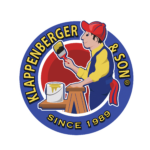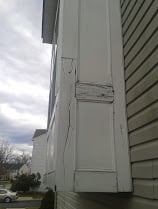You properly prep the surface to ensure it is clean and free of any loose paint, apply one primer coat and two finish coats, and the paint starts peeling one year later. What happened?
The chances are overwhelming that the moisture content in the wood was too high.
The last thing anyone wants is for paint to peel. But you might not know that there’s a simple step you can take to prevent peeling paint. It’s called a moisture meter, and it measures the moisture content of the wood.
Many people take this for granted. After all, most online painting tips fail to mention that you should check the surface’s moisture levels before applying a stain or a coat of paint. You also won’t even typically notice high moisture content without using a professional reader. But moisture levels above 16% for primers, paints, and most stains will result in paint peeling.
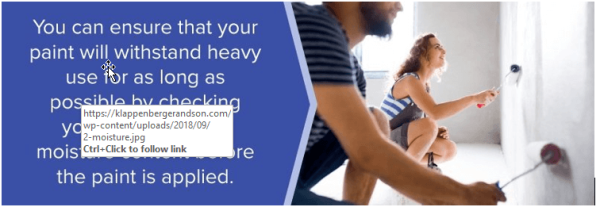
At Klappenberger & Son, we know just how important it is to test the moisture content before painting. It doesn’t matter how much prep work and sanding do. It doesn’t matter if you use the best primers, and premium grade paint money can buy. If the moisture content is 16% or higher, – the paint will peel. The higher the moisture content, the more likely it will peel.
Before and during the job, we check all exterior wood moisture content before painting. Read on to learn more about paint failure, the importance of moisture content management, and the process we use to balance your walls’ moisture levels.
Why Does Paint Peel?
There are three primary reasons why paint can peel.
First, the top coats did not stick to the substrate. In other words, it was not primed. In most cases, bare, glossy, slick surfaces or painted with an alkyd should be primed with a bonding primer.
Secondly, any foreign substance, such as glue or oils, can inhibit adhesion. When wallpaper is removed and the walls are painted, it is necessary to prime them with a primer-sealer.
The most common reason paint peels, however, is moisture gets behind the paint, and the UV from the sun pulls it through. If the paint doesn’t allow water to pass, the paint will bubble or crack.
All exterior paints will allow some moisture to pass through without peeling. But over time, the sun’s powerful rays decrease the paint’s flexibility, and the paint cracks when water gets behind it.
Paint loses its flexibility; like dry skin, it cracks. The paint has terrific flexibility in the early stages of just being painted.
If you’re unsure why your paint is peeling, checking the moisture levels is one of the first steps you should take. Even if surfaces feel dry to the touch, they could still harbor excessive dampness that eats away at paint and damages the overall structure.
FYI – the human hand is not able to detect moisture anywhere near the 15% threshold.
A true story about moisture content and painting:
I painted a pergola before, and it rained the next four days. Fortunately, most of the pergola was fine, but there were a few bubbles. She described them as big pockets of water! I asked her to pop the bubbles, and I would return to repaint it in a few days. After returning in a few days, I could hardly find the bubbles. The paint had been reattached to the pergola. Amazing! We sanded them off and repainted them. If the paint job were older, the paint wouldn’t have been so flexible, and it would crack and peeled.
Exterior paint is susceptible to harsh elements, peeling with excessive heat or rain and snow. Therefore, it’s essential to make sure water can not get into small cracks and cause peeling paint and rot.
Interior paint is also exposed to high moisture levels. Using a high moisture content paint such as Duration from Sherwin Williams in bathrooms would be a good choice.
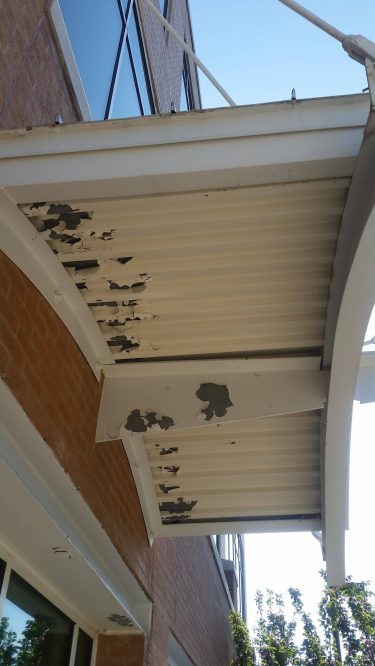
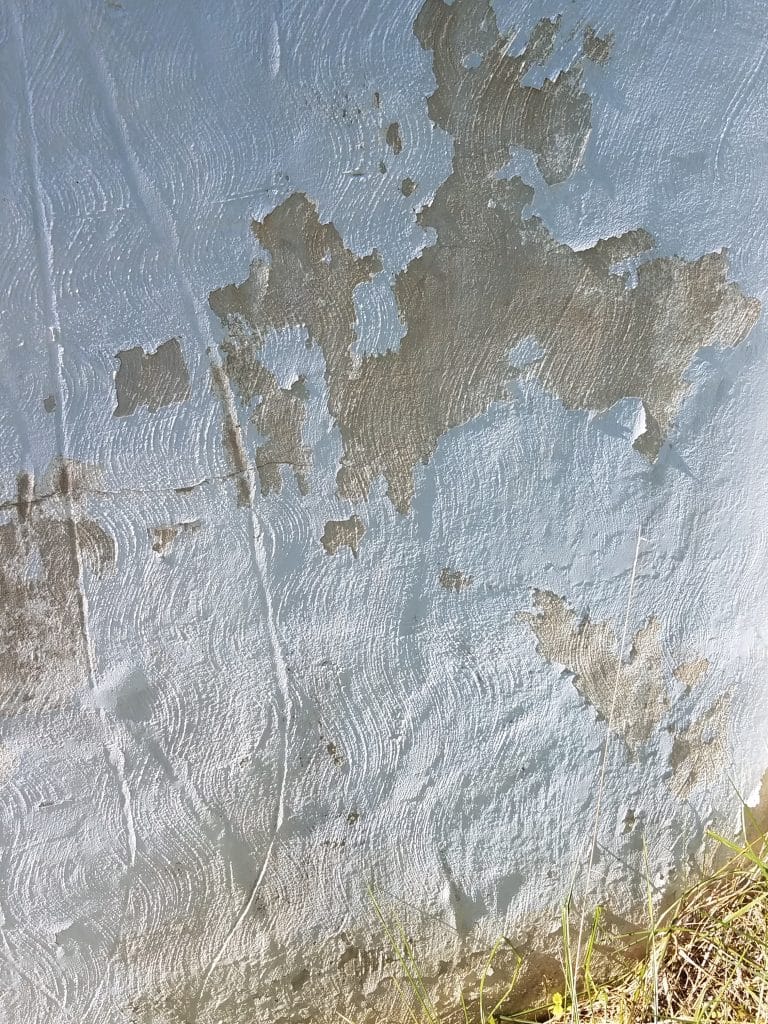

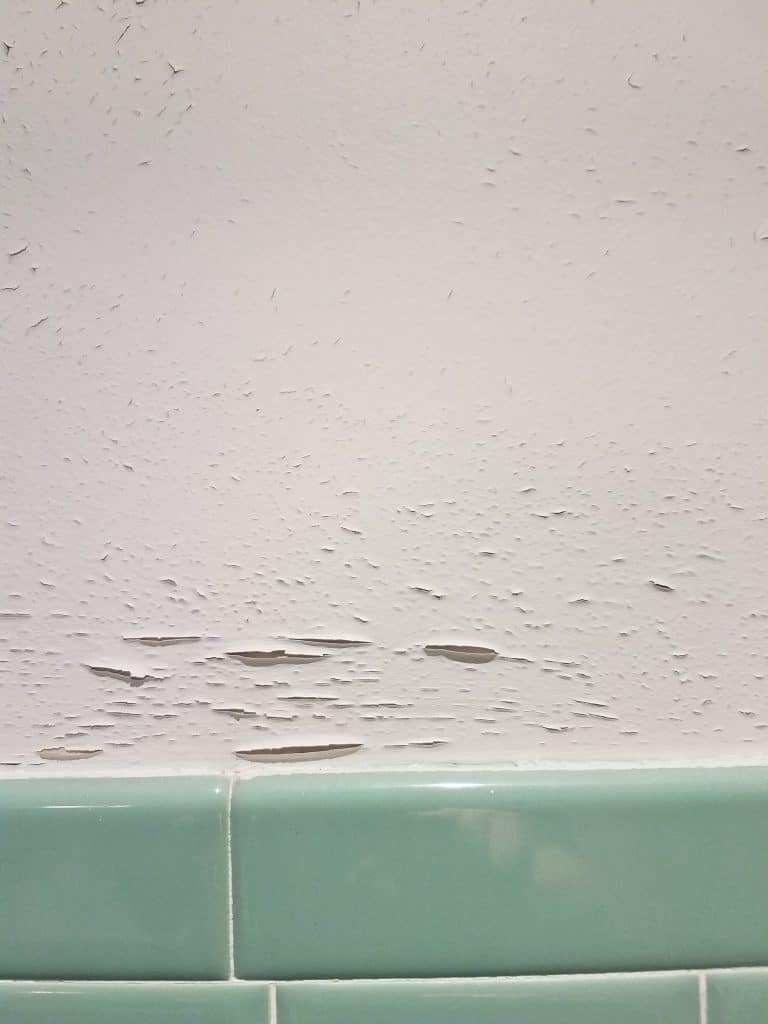
Exterior walls are regularly exposed to moisture. And while these walls are built to be water-repellant, excessive water over time can lead to moisture retention.
Some of the factors leading to high exterior moisture levels include:
- clogged gutters
- worn-out caulking
- sprinkler systems that make regular contact with the home
- paint that was applied to previously damp surfaces.
Moisture content and painting the most common culprit for peeling. This could be caused by butt joints not primed. Water loves to find a butt joint and wick into it just like a candle.
Butt joints can be found wherever two pieces of trim are connected in any direction.
These butt joints need to be sealed and if possible prime wood butt joints if you are replacing the wood with new wood. You can caulk it but don’t paint it until the moisture content drops below 16%.
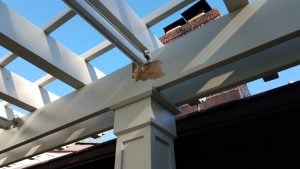
When removing rotten wood, make sure all softwood is removed or the rot will come back. And yes, the paint will likely peel.moisture content and painting
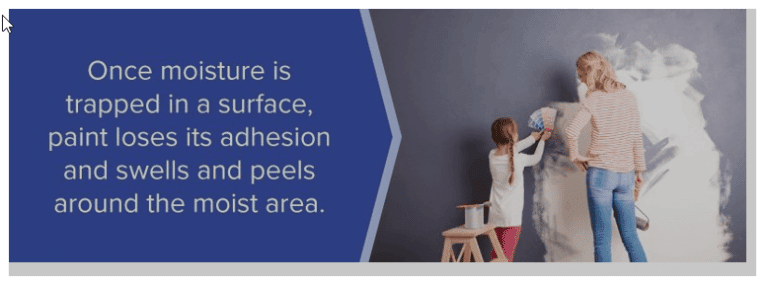
Once moisture is trapped in a surface, paint loses its adhesion and swells and peels around the moist area. Peeling often begins along the edges of a board or drywall and spreads along the rest of the surface over time. You might notice a brownish water stain before the paint starts to chip shortly after.
And not only does moisture retention itself peel paint, but dampness might also result in surface rot to wood siding, boards, or frames.
Consequences of Water Retention
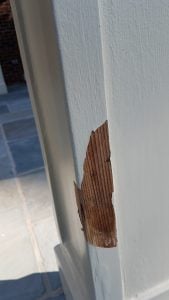
Unaddressed water retention can attract wood-decaying fungi, which creates rot. This rot eats away at and softens the wood. It can also attract mold, insects, and other pests that further break the wood apart. Window frames and doorways are some of the most common problem spots for surface rot, but the fungi can easily spread to non-wood surfaces.
When surface rot breaks wood apart and attracts wood-eating insects, the paint no longer has a smooth surface to stick onto and quickly begins to peel. You might first notice a white or grey growth on the wood, which quickly gives way to blistering, peeling, or cracked paint. If wood surfaces feel soft or spongy, the paint is likely peeling due to surface rot.
How to Manage Moisture Content
Controlling both interior and exterior surfaces’ moisture content is vital in ensuring that paint sticks to your walls and surfaces for years. After all, you don’t want to waste your money on a paint job that is bound to fail from the beginning.
If you don’t currently suspect high moisture content but want to protect your walls from potential problems both before and after a paint job, you can choose to manage moisture content on your own. But if your paint is currently peeling and you suspect high moisture levels, hiring a professional to take a reading and quickly address any pressing issues with the walls and paint is your best choice in ensuring your paint’s longevity and your building’s health.
Managing Moisture Levels Personally
Preventing and inspecting for high moisture levels is relatively easy.
Taking preventive measures is helpful if you’re getting your walls painted soon or recently had your walls painted and want to make sure the new paint stays in good condition for as long as possible. You can also manage moisture content when building a new home or business to prevent any damage after construction is complete.
The Environmental Protection Agency created an extensive guide to controlling moisture content during the construction of new buildings. But these points can also be applied to current residential and commercial properties.
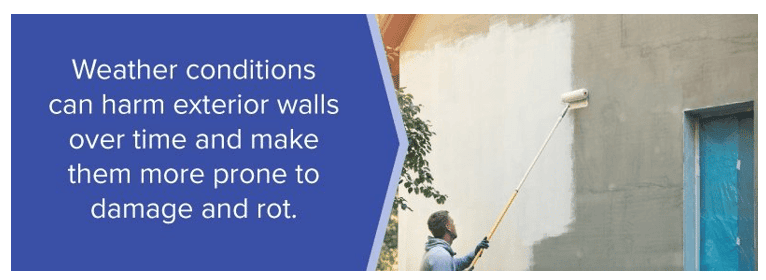
How to lower Moisture levels
- Drain water or snow away from the building. Weather conditions can harm exterior walls over time and make them more prone to damage and rot. Divert any water away from walls or other susceptible surfaces.
- Provide a clear path for water to exit. Roof drains should stay clear at all times to channel rainwater away from the building. Clean leaves and debris from the drains regularly.
- Prevent plumbing leaks. If toilets, showers, or sinks continuously leak, the walls and floor will take significant damage over time. Checking plumbing supply valves occasionally is recommended.
- Use ventilation systems to keep interior walls dry. Exhaust fans remove water vapor from showers, cooking areas, locker rooms, or indoor recreational areas such as indoor pools. Make sure that the fans in your building work properly, and consider installing air conditioners with dehumidifiers set to activate at a certain dew point.
- Inspect walls, roofs, ceilings, plumbing systems, and thermostats periodically. Inspecting the water flow of your downspouts is a best practice. Inspect your ceiling below the bathroom for signs of water damage. Check the caulking around the tub for cracks. If caulking is starting to crack or peel make sure you get a bathroom silicone caulk.
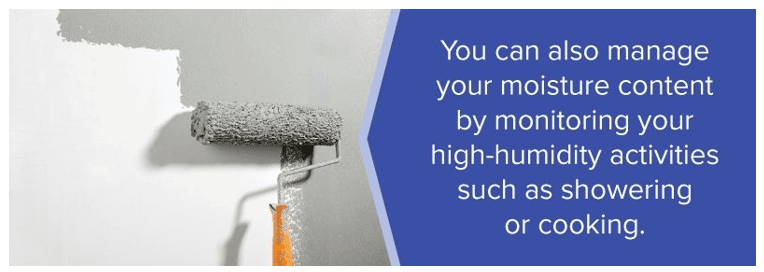
Taking Action To Reduce Moisture Issues
You can also manage your moisture content by monitoring your high-humidity activities such as showering or cooking. Do the children take long hot showers without turning on the fan? If so, having the fan wired to the light switch can eliminate that issue. This simple fix can save you hundreds on repairs.
But if you find that your walls’ moisture is dangerously high or if your paint’s already peeling, repainting over the spot, or trying to fix the problem yourself won’t solve the underlying issue. It’s often best to contact a professional and get accurate moisture reading.
2. Professional Moisture Content Management
Hiring a professional to check and manage moisture in your walls is always a good idea. Still, it’s essential if you’re interested in getting your home repainted soon or if you suspect that water damage is already destroying your walls and peeling your paint. And if your building was recently flooded, it’s best to contact a professional even if you don’t immediately see any signs of damage. A professional painter will take the steps necessary to lower the moisture content before repainting the affected walls.
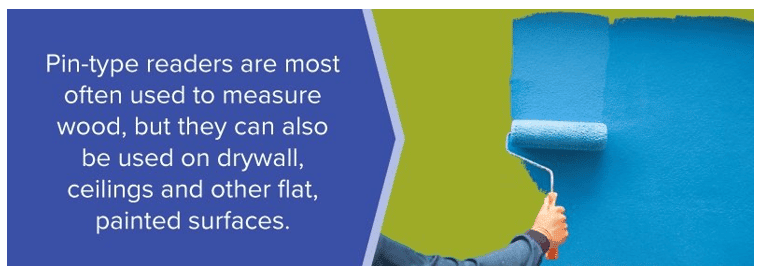
An experienced painter can assess high moisture levels using moisture meters or other testing methods. In fact, it’s imperative for any painter to diagnose and repair water damage immediately so that new paint isn’t compromised. These professional moisture meters and tests accurately measure water damage so that necessary action can be taken:
Types of Moisture Meters
- Pin-type meter: Also known as a destructive or invasive moisture meter, a pin-type meter uses two contact pins that penetrate the desired surface at a set depth. The meter measures the electrical resistance between them to determine the percentage of moisture content. Pin-type readers are most often used to measure wood, but they can also be used on drywall, ceilings, and other flat, painted surfaces. These meters are best when looking to identify precisely where a water buildup occurred.
- Pinless meter: A pinless moisture meter — also called non-destructive or non-invasive — reads water content levels at a wall’s surface without penetration by using electrical impedance. Pinless meters are especially useful for assessing water buildup behind showers, bathroom tiles, and other finished surfaces. Painting a bathroom or painting a kitchen requires extra attention to detail because of the amount of moisture content the walls are likely to have.
- All-in-one meter: Perhaps the most useful type of moisture meters, an all-in-one meter uses both pin and pinless technology to measure moisture levels. This versatile option can be used to read nearly any kind of material.
What To-Do When You Find High Moisture Content
Professional readings can determine where the problem lies and how severe the damage is. If you’ve recently had a flood or other serious water damage, moisture levels will most likely be too high to repaint the area safely. Completely replacing a flooded surface is more cost-effective than just painting over it. Further, repainting without taking care of underlying damage will multiply the problem and create more severe future issues.
But if your wall or surface is healthy enough to be fixed without complete replacement, it will still need to be sanded and repainted to protect the surrounding area and prevent further damage. Carpentry skills are a necessity when repairing and repainting damaged surfaces. Contact a painter with complementary carpenter skills — such as Klappenberger & Son if you are in the Maryland area — to guarantee that you’re getting the best service and a paint job that won’t chip due to untended damage.
What Happens If You Don't Check Your Moisture Content?
If you don’t check walls’ and surfaces’ moisture levels, you run the risk of repainting the surface in months, not years. Remember, no amount of prep work, primers, or premium grade paints will save you from painting damp surfaces. Painting contractors blame the paint, but most of the time, it’s damp wood. A moisture meter can be purchased at paint stores, but a surprisingly small inventory is kept, so call or go online and order one.
Rot and Deterioration: Lets Remove and Prevent It!
The trapped moisture will result in surface rot and deterioration on both interior and exterior surfaces. Fungi and insects eat away at wood and other materials, which causes irreversible damage if not treated quickly.
Once again, moisture content and paint make for a poor combination.
Mold, which grows in any damp environment takes hold of the area nearly as soon as dampness appears. A mold colony can form on a wet surface within 24 to 48 hours if preventive measures aren’t taken. Mold continues to spread from one board to another until it is removed.
You might first start to notice mold through wall and ceiling discoloration or its musty smell. If it’s seen quickly, you can sometimes disinfect the area and prevent the decay from spreading. But if mold has damaged over 25 square feet of a surface, you’ll need to hire a professional to have it removed. Most often, the entire wall will need to be replaced and completely renovated. Renovation could cost anywhere between $500 and $1,000, a needless expense if preventive steps had been taken.
Degeneration of Old and Historic Buildings
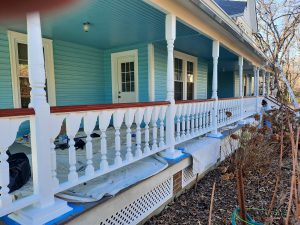
Surface rot prevention mainly plays a critical role in the preservation of historic buildings. Rot eats a
way at the fragile building itself and prevents the paint from sticking to the walls, which can ultimately deteriorate an old home.
The longevity of many historic buildings can be traced to their paint. Paint is one of the most important materials that preserve historic buildings, as it protects the wood siding from deterioration.
Paint shelters a wall similar to the way sunscreen protects your body from the sun or the way insulated coats keep you from the cold winter elements. As you age, it becomes more critical to shield your body from harsh weather. Likewise, it becomes more crucial to protect a building’s paint as it ages.
Checking the moisture content and painting is crucial but not the only factor for getting maximum longevity.
Health Problems
The World Health Organization warns that dampness in walls and other indoor surfaces can fill your home with dust mites, fungi, bacteria, allergens, and viruses that thrive in moist environments. Pollutants can have a lasting impact on you and everyone else in a building.
You might never have considered the lasting effects that mold and other fungi and bacteria have on your health. But health concerns due to mildew and rot have been linked to allergy problems and severe lifelong issues. These include:
- Respiratory problems such as wheezing and asthma
- Nasal and sinus congestion
- Eye irritation such as burning, itching, and watering
- Skin irritation such as rashes, hives, eczema, dermatitis, and acne
- Problems with the nervous system such as headaches, memory loss, and mood swings
- Aches and pains
People with immune system complications and chronic lung conditions can be severely impacted by mold introduced into the home when high moisture isn’t treated. Because high moisture levels affect both your home and your health moisture content prior to painting is imperative.
Our Process
At Klappenberger & Son, we do what any good painter should — test all areas for water damage before applying paint.
We understand that you want your paint to last a long time, and so do we. We never paint over damage because you deserve the highest quality job possible for your home or business. Our process involves fully testing an area before applying paint to ensure that the paint lasts for years to come.
Been locally operated since 1989!

Before beginning the painting process, we use professional moisture meters to find any potential problem spots with both interior and exterior surfaces. We mark off any troublesome with blue tape and will bring these areas to your attention prior to doing any corrections.
We also replace rotten renewable composite material that does not absorb water. This takes all the guesswork out of wondering if the surface is damp. It’s not. And when premium paint is applied you can expect the paint job to last ten years. If you are going to replace the wood you might as well replace it with these products like Borel or Azek. This type of product will never rot and the fact that the paint job will last twice as long as wood makes the extra cost a moot point.
The trained professionals at Klappenberger & Son focus on integrity and attention to detail from start to finish with every job we do. Rather than just doing a shoddy job quickly, we give our customers consistent and predictable results. And with over 400 positive reviews, our record speaks for itself.
We’ve been a leader in interior and exterior painting for residential, commercial, and government properties since 1989, and we continue to paint some of the finest homes in the Annapolis, Baltimore, and Montgomery County regions. Contact us today to see what we can do for you in managing the moisture content and repainting of your walls, and trust us to provide the high-quality work you and your building deserve.
